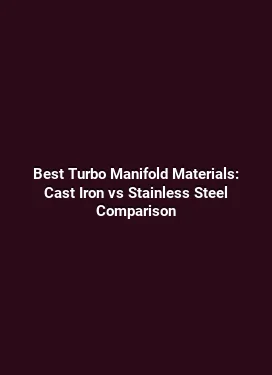Best Turbo Blankets for Heat Management: Titanium vs Fiberglass Review
Turbo blankets play a pivotal role in optimizing engine performance by managing heat around turbochargers. This in-depth examination compares two popular materials—titanium and fiberglass—through practical testing, installation considerations, and real-world scenarios. The goal is to provide actionable insights for enthusiasts seeking reliable thermal management, improved efficiency, and longer-lasting components without relying on generic statements. Each section dives into material behavior, mounting strategies, durability under harsh conditions, and how these blankets perform under different driving regimes such as street use, track sessions, and off-road environments.
Material Fundamentals: Titanium vs Fiberglass in Turbo Blankets

Titanium turbo blankets are celebrated for their exceptional strength-to-weight ratio and high-temperature tolerance. Their construction typically involves woven or braided titanium fibers with an inner insulating layer designed to reflect and trap heat away from surrounding components. The result is a blanket that provides robust performance in high-heat zones such as near exhaust manifolds and turbine housings while minimizing heat soak to nearby plumbing, sensors, and intake systems. A practical benefit is reduced radiant heat transfer, which can contribute to cooler charge temperatures and more consistent turbocharger response during repeated spool cycles.
Fiberglass turbo blankets, on the other hand, rely on mineral-based fibers layered with a reflective outer surface or metallic foil. The insulating core is highly effective at absorbing and dissipating radiant heat, making fiberglass blankets a cost-effective solution with broad compatibility. In real-world terms, fiberglass blankets deliver reliable protection against heat without adding significant mass or constraint to tight engine bays. The material tends to be more flexible during installation and can be easier to tailor to non-standard orientations, which matters on compact or unusual engine layouts.
Durability Under Pressure: Resistance to Heat, Chemicals, and Mechanical Stress

When evaluating durability, the resistance to high temperatures is the primary metric. Titanium blankets typically endure sustained exposure well beyond 1,000 degrees Celsius in certain configurations and maintain structural integrity during rapid thermal cycling. The downside is that titanium can be stiffer, requiring careful fitment to avoid abrasion against hot exhaust components or sharp edges. In practice, a well-fitted titanium blanket benefits from secure fasteners and a protective wrap to prevent movement that could lead to wear over time.
Fiberglass blankets exhibit excellent resistance to heat, withstanding the typical heat ranges seen in most turbocharger installations. They may be more prone to compression or fiber migration if subjected to harsh vibrations without proper mounting hardware. A practical tip is to pair fiberglass blankets with high-temperature rated straps or clamps and to verify that the blanket is seated away from moving parts that could cause chafing. Regular inspection after initial miles can catch early signs of fiber shedding or edge fraying, which, if addressed promptly, preserves effectiveness and safety.
Thermal Performance: How Each Material Manages Heat in Real Driving Scenarios
Thermal management is not a single-number metric; it involves radiant heat suppression, convective cooling, and the blanket’s ability to maintain consistent performance during rapid spool/load changes. Titanium blankets tend to excel in environments with extreme heat and frequent high-load events. The reflective surface and dense weave help to minimize heat flux toward adjacent components, promoting more predictable turbocharger behavior during aggressive driving, hot-lapping, or sustained highway pulls where heat buildup can become a limiting factor.
Fiberglass blankets shine in scenarios where heat needs to be absorbed and contained without excessive weight or stiffness. The insulating core reduces radiant heat transfer effectively and can help stabilize intake temperatures by limiting excessive heat reaching intake plumbing and intercooler piping. This can translate into steadier air charge characteristics and more uniform boost response across a range of RPMs, especially in configurations with compact engine bays where heat tends to accumulate quickly.
Practical Testing Insights: Temperature Profiles and Real-World Feedback
In controlled demonstrations, titanium blankets often show lower peak surface temperatures on adjacent components during sustained high-load runs. This effect is accompanied by a slight reduction in heat soaked into nearby heat-sensitive areas, such as valve covers and turbo oil lines, when the blanket is properly oriented. For daily drivers and weekend warriors, that translates into cooler under-hood temperatures and a more forgiving temperature rise after hard pulls.
Fiberglass blankets typically deliver a robust temperature drop relative to baseline measurements without blankets, especially in heat-soaked conditions. The insulation tends to be less reactive to rapid ambient temperature fluctuations, offering stable performance when ambient heat interacts with engine heat. A practical takeaway is that fiberglass blankets can be a forgiving, reliable choice for a wider range of engine bays and configurations, particularly where space constraints or mounting complexity favors a more flexible install.
Installation Considerations: Fitment, Mounting, and Longevity
Installation quality strongly influences thermal performance and component protection. Both materials benefit from precise trimming, proper seam alignment, and the use of weather- and heat-resistant fasteners. Titanium blankets, with their higher stiffness, may require careful pre-fitting, trimming, and step-by-step increments to secure the blanket without introducing gaps. A snug fit minimizes movement at high RPMs, reducing the risk of edge abrasion and fabric wear over time.
Fiberglass blankets often allow easier initial positioning due to their flexibility. The installation process should still follow a methodical approach: clean mounting surfaces, align seams away from hot surfaces, and ensure clamps or straps do not compress the blanket unevenly. An evenly tightened strap system distributes clamping force, helping maintain the blanket’s integrity across the full operating temperature range.
Mounting Strategies for Tight Engine Bays
When space is limited, consider modular blankets with segmented designs that can be wrapped around curved manifolds or turbine housings. For titanium blankets, using a combination of shielded tie-downs and ceramic-coated mounting brackets can reduce the risk of direct contact with sharp edges. For fiberglass blankets, selecting heat-resistant adhesive-backed pads or non-adhesive mounting hardware can provide a clean, vibration-resistant setup without compromising insulation.
Common mistakes include installing with protruding edges that rub against hoses, sensor housings, or coil packs, and using overly aggressive clamps that pinch fabric. The goal is to create a secure, gap-free envelope around the hot zone while leaving enough clearance for nearby moving components and thermal expansion during heat cycles.
Maintenance, Longevity, and Safety Considerations
Regular inspection is essential to preserve performance and safety. Titanium blankets should be checked for any onset of edge fraying, compromised seams, or signs of wear where the blanket contacts hot surfaces. If any damage is observed, replacement or repair should be considered before a noticeable loss in thermal protection occurs. In most cases, minor fabric wear can be addressed with edge sealant or by trimming and resecuring the affected area, provided the overall integrity remains intact.
Fiberglass blankets require attention to fiber sheen, edge integrity, and any signs of delamination or tearing. Fiber shedding is a potential indicator of mounting stress or degradation due to prolonged exposure to vibrations. Cleaning should be done with non-abrasive methods, avoiding harsh solvents that can degrade the insulating core. Replacement intervals vary by driving style, but proactive replacement after extended high-load sessions helps maintain consistent performance and reduces the risk of thermal damage to adjacent components.
Maintenance Routines for Optimal Performance
Establish a routine that includes a visual inspection after aggressive driving or track days, checking for loose fasteners, misalignment, or hotspots on surrounding parts. Keep mounting hardware clean and dry to prevent corrosion, and document any temperature-related observations during heat soak tests. A well-maintained blanket contributes to stable boost behavior, more predictable exhaust gas temperatures, and better overall engine response during a range of operating conditions.
Real-World Scenarios: Case Studies and Practical Lessons
Consider a high-performance street build with an aggressively tuned turbo and a tight engine bay. A titanium blanket installed with precision mounting can deliver measurable reductions in under-hood temperatures, supporting longer intake pipe life and reduced heat-related stress on nearby sensors. In this context, the blanket’s stiffness may require careful shaping to preserve clearances but rewards the owner with a more consistent power curve during repeated drags and hill climbs where heat buildup is a key limiter.
In another example, a mid-power setup in a compact platform benefits from fiberglass insulation due to its forgiving installation and effective heat containment in a cramped layout. The blanket’s flexibility allows for easier contouring around manifold bends and sensor probes, reducing installation time and enabling a rapid return to daily driving duties after a track session. The result is reliable thermal protection without sacrificing accessibility for maintenance or sensor service.
Comparative Guide: Choosing the Right Blanket for Your Engine
Selecting between titanium and fiberglass depends on several factors: heat intensity, space constraints, mounting complexity, and long-term maintenance preferences. For setups with extreme heat flux and a priority on minimizing heat transfer to sensitive components, titanium blankets offer high-end performance with durable protection, provided the installation is meticulous and components are kept clear of contact points. For configurations where ease of installation, versatility in mounting, and broad compatibility are valued, fiberglass blankets provide robust insulation with straightforward handling and maintenance.
Engine bay design quality also matters. Vehicles with well-organized routing and ample clearance benefit from the precision and rigidity of titanium blankets, whereas engines with tighter clearances can benefit from the adaptability and conformability of fiberglass blankets. In either case, aligning the blanket to specific heat sources, such as turbine housings or exhaust manifolds, while ensuring clean integration with surrounding hardware, is essential for achieving consistent results across a range of operating conditions.
Practical takeaways include verifying proper coverage of the hottest zones, ensuring no contact with moving parts, and maintaining a clean, dry installation environment. By focusing on proper fitment, robust mounting, and planned maintenance, enthusiasts can realize the performance and reliability benefits offered by either material choice while minimizing potential drawbacks associated with improper installation.






